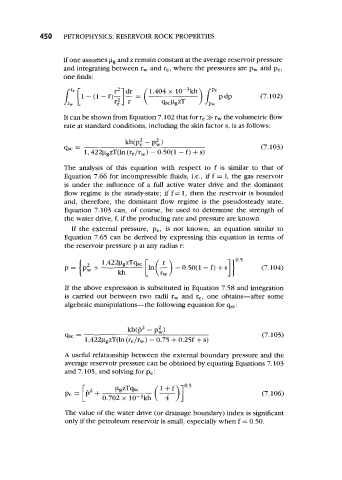Page 482 - Petrophysics
P. 482
450 PETROPHYSICS: RESERVOIR ROCK PROPERTIES
If one assumes pg and z remain constant at the average reservoir pressure
and integrating between r, and re, where the pressures are pw and Pe,
one finds:
It can be shown from Equation 7.102 that for re >> r, the volumetric flow
rate at standard conditions, including the skin factor s, is as follows:
WP: - P3
qsc = (7.103)
1, 422pgzT(ln (re/rw) - 0.50( 1 - f) + s)
The analysis of this equation with respect to f is similar to that of
Equation 7.66 for incompressible fluids, Le., if f = I, the gas reservoir
is under the influence of a full active water drive and the dominant
flow regime is the steady-state; if f = 1, then the reservoir is bounded
and, therefore, the dominant flow regime is the pseudosteady state.
Equation 7.103 can, of course, be used to determine the strength of
the water drive, f, if the producing rate and pressure are known.
If the external pressure, Pe, is not known, an equation similar to
Equation 7.65 can be derived by expressing this equation in terms of
the reservoir pressure p at any radius r:
1'422pgzTqsc [.( 2) - 0.50(1 - f) + s
(7.104)
If the above expression is substituted in Equation 7.58 and integration
is carried out between two radii r, and re, one obtains-after some
algebraic manipulations-the following equation for qsc :
WP2 - P:)
qsc = (7.105)
1,422pgzT(h (re/rw) - 0.75 + 0.25f + s)
A useful relationship between the external boundary pressure and the
average reservoir pressure can be obtained by equating Equations 7.103
and 7.105, and solving for Pe:
(7.106)
The value of the water drive (or drainage boundary) index is significant
only if the petroleum reservoir is small, especially when f = 0.50.

